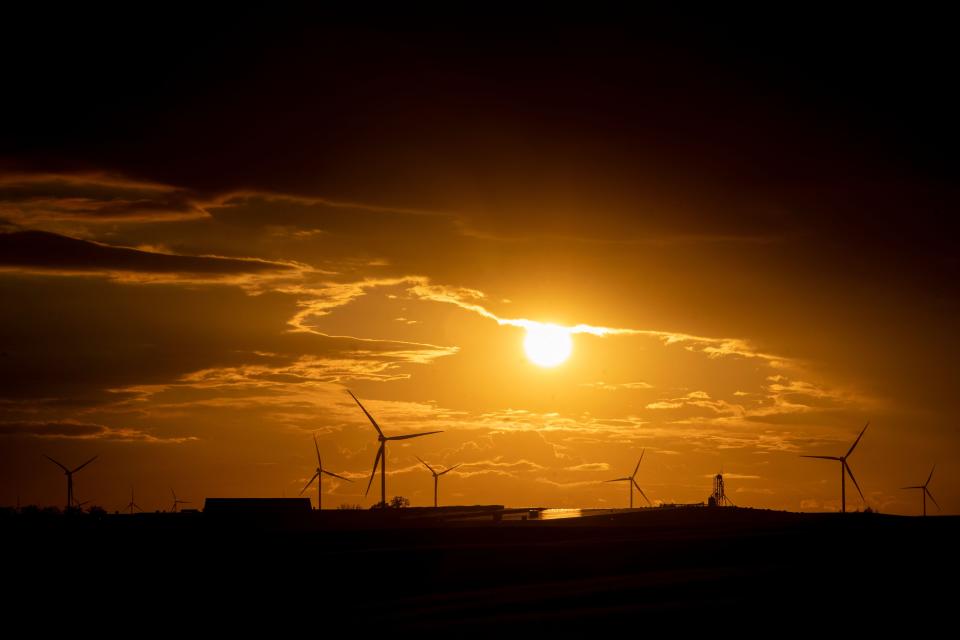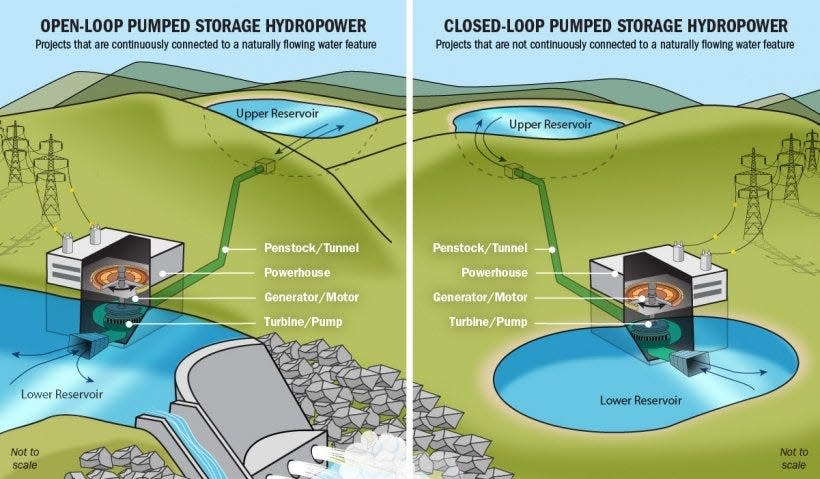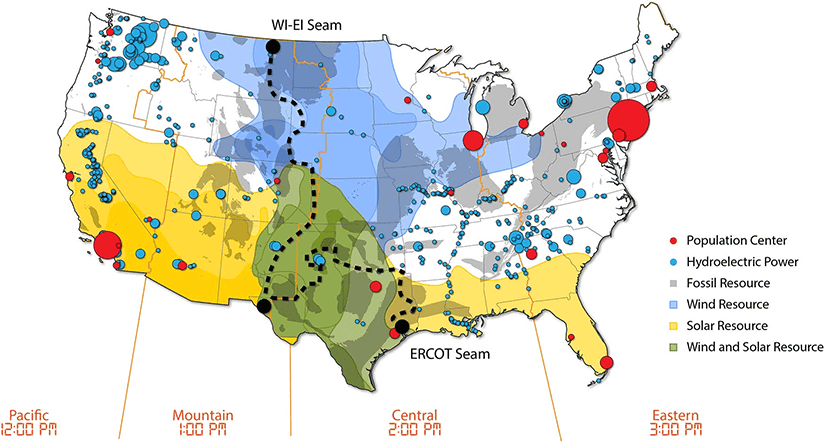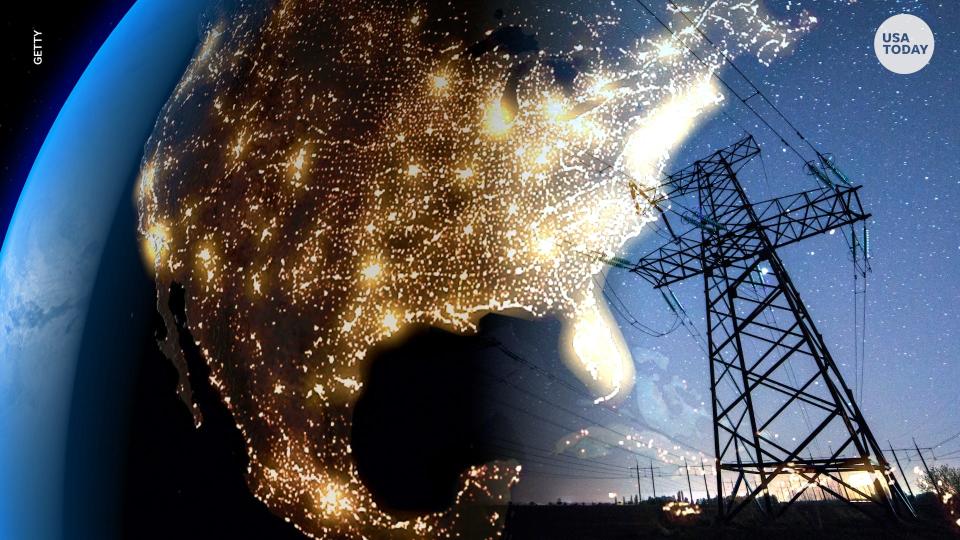Can we count on renewable energy? Four ways wind, solar and water can power the US

In February 2021, the electric grid failed in Texas.
A particularly brutal winter storm system had struck the state and, as temperatures plunged, millions of people were without power or heat for days. Pipes burst, flooding homes. Water treatment facilities went offline. Hundreds of people died.
"People were literally burning furniture inside their house for heat," Selena Xie, president of the Austin EMS Association, told USA TODAY.
Politicians and other public figures were quick to blame the tragedy on renewable power.
"It never would have been an issue had our grid not been so deeply penetrated by renewable energy sources that contribute the least when they are needed the most," Texas Public Policy Foundation, a state think tank, said in a statement.
These claims echoed a widespread belief seen in mainstream political discourse and social media chatter that replacing “reliable” fossil fuel power sources with “unreliable” renewable power technologies will inevitably lead to catastrophe.
However, renewables were unfairly blamed for the disaster in Texas. While wind facilities did underperform or fail, the outage was primarily caused by the failure of natural gas infrastructure and supply chains, experts said.
Claims that renewables are intrinsically unreliable are also off base. Renewable energy sources are necessary to reduce CO2 emissions from the electric grid and the escalating harms caused by global warming, and with proper planning grids can increase use of these resources without sacrificing reliability, experts told USA TODAY.
“The truth of it is every resource has its own unique characteristics to plan for,” said Trieu Mai, a researcher in the Grid Planning and Analysis Center at the National Renewable Energy Laboratory. “There is no intrinsic reason why a renewables-based grid would be more prone to blackouts. But it does require planners to account for the characteristics of those renewables when they do their planning.”

Can renewable energy replace fossil fuels?
To deal with the intermittent nature of some renewables, grid planners have a variety of strategies in mind:
Storing power to be used later
Transmitting power over distance
Creating resource diversity with different types of renewables
Using “demand response” initiatives to encourage consumers to use power when it is plentiful
For an electric grid to work properly, operators must make sure that power supply meets power demand instantly – managing random fluctuations in consumer use and the typical peaks and troughs of the day or year.
Renewables like solar or wind that fluctuate with weather add another layer of complication. Some fluctuations are predictable ? such as solar power production increasing as the sun rises and peaking in the afternoon ? but others are less so.
“Renewable generation could swing rapidly and suddenly within a region due to cloud coverage or wind speed or direction changes,” said Andy Sun, a Massachusetts Institute of Technology electric power systems professor.
Storage: Save power until it's needed
One option for managing these fluctuations is to store energy that is produced when power is plentiful and use it when power becomes scarce. This strategy functionally transforms "intermittent" renewable power into "dispatchable power" ? meaning the power is guaranteed to be available for a given time, even if the weather is bad.
Giant lithium-ion batteries – the variety found in electric cars and cell phones – are being rapidly deployed for this purpose. The most common utility-scale lithium-ion battery stores power for about four hours, enough to push through, for instance, an evening peak demand period after solar plants have largely stopped producing, according to Mai.
“In the longer term … you might need to shift it further than four hours,” he said. “What we see in our analysis is an increasing duration of energy storage needed as you significantly increase renewables on the grid.”
Other technologies can store power for longer and require less intensively mined minerals than batteries. For instance, pumped storage hydropower has been used for energy storage for decades, according to Robert Armstrong, chair of the Massachusetts Institute of Technology Energy Initiative's 2022 report, "The Future of Energy Storage."

In this system, excess energy produced during peak production periods – such as mid-afternoon on a solar-driven grid – is used to pump water up an incline to a reservoir. When energy is needed, the water is released to flow back downhill, creating electricity by spinning a turbine.
These facilities can store many hours' worth of energy depending on their size.
Other energy storage strategies, which are in varying stages of research and development, include:
Thermal energy storage – A material, such as sand, is heated with excess power and then stored. When needed, the hot material is used to pressurize a gas, which then spins a turbine.
Alternative chemistry batteries – Alternative materials are used to construct a battery that stores power for longer or more cheaply than traditional lithium-ion batteries.
Gravity storage – Something heavy, such as sand or blocks of concrete, is lifted when energy is plentiful and then dropped during times of need, creating power through regenerative braking. Researchers have proposed repurposing existing mines for this type of storage.
Compressed air storage – Excess power is used to pump and compress air in underground chambers, which is released to spin a turbine when needed.
Hydrogen fuel – Excess renewable energy is used to split hydrogen from water, which can then be transformed into electricity by a fuel cell.
Transmission: Move power to where it's needed
Another option to fill the gaps on cloudy days or windless nights is importing renewable power from elsewhere via electrical transmission lines, according to Mark Jacobson, a professor of civil and environmental engineering at Stanford University.
"When the wind is not blowing in one place, it is often blowing somewhere else, and vice versa," he told USA TODAY in an email.
Currently, the U.S. electric grid is divided into three broad sections that operate almost independently of each other and differ in renewable resource distribution and abundance. Connecting the eastern and western parts through increased transmission capacity could help the U.S. make better use of its abundant renewable resources, according to a 2021 study led by the National Renewable Energy Laboratory.
For instance, these improvements would allow excess solar power from the Southwest to support Eastern communities during peak demand, according to the Department of Energy. Likewise, Midwestern wind power could be sent in the opposite direction as the sun sets on the West Coast.

Large interconnected grids allow "resources of different types – meaning solar, geothermal, hydropower and various storage technologies – to work together," Mai said.
Resource diversity: Leverage complementary renewables
This sort of resource coordination, or resource diversity, is itself an important strategy for keeping the lights on. For wind and solar energy specifically, grid operators can take advantage of a convenient characteristic that allows them to be used in tandem.
"Wind and solar, which are both ... intermittent resources, are complementary in nature," Jacobson said. "When the sun is not shining, the wind is often blowing ... and vice versa. Thus, combining wind and solar on the grid smooths out the overall electricity supply over time."
Planners can take advantage of this quality by coordinating wind and solar across the U.S., within a specific region, or even within the same power plant, Caitlyn Clark, a National Renewable Energy Laboratory researcher and co-author of a 2022 hybrid power plant study, told USA TODAY.
Including other types of renewables brings additional benefits.
For instance, both hydropower and geothermal power can offer dispatchable power to the grid, which may reduce the need for storage in areas where these resources are available. And geothermal technologies can also reduce the amount of demand on the electric grid by providing direct heating and cooling in buildings, Amanda Kolker, the geothermal energy laboratory program manager at the National Renewable Energy Laboratory, told USA TODAY.
Demand response: Incentives for using less power when renewables are producing less
Reducing demand, or at least moving demand around in time, is yet another key strategy for managing a renewables-dominated grid, experts say. This can be accomplished with demand response initiatives, which provide incentives for consumers to reduce power consumption during times of peak demand.
This can help shift demand to better coincide with peak wind and solar energy production.
"Right now our mindset is, 'There's demand for power out there and we have to create an electric grid to serve it,'" Jim Robb, CEO of North American Electric Reliability Corporation, an electric grid regulatory authority, told USA TODAY. "Another way to think about this problem is ... 'How do we shape the demand curve to take advantage of what the system naturally wants to produce?'”
Such programs have already been deployed to avoid blackouts on fossil fuel-dominated grids. For example, one Texas utility remotely accesses the thermostats of program participants and adjusts them by 2 to 4 degrees to reduce community power usage during peak demand or extreme weather. The participants receive financial compensation and can override the adjustments manually if they choose.
A 2021 study found incentive-driven demand response programs have the potential to reduce the power needed during Texas summer and winter peak demand by 19,000 megawatts. That's about the same amount of electricity that would be generated during peak demand by 10 or 11 recently proposed new gas power plants, according to a press release for the study.

Is it possible to power the grid with 100% renewables?
Wind, solar, hydropower and geothermal energy produced about 20% of U.S. power in 2022. Researchers say that, through the right combination of the available strategies (tailored to different geographic areas), significantly higher levels are attainable in the near term.
This is true even when accounting for the increasing demand associated with electrifying other sectors of the economy, such as transportation.
Multiple research groups have proposed models of renewables-dominated systems. For example, Jacobson and his colleagues modeled a grid that would run on 100% solar, wind, hydroelectric, geothermal, tidal and wave power and storage by 2050.
Mai and other researchers modeled various scenarios where a combination of wind, solar, hydropower and storage could contribute up to 95% of electricity by 2035, with fossil fuels and nuclear making up much of the rest.
However, he said including nuclear and fossil fuels in this mix doesn't mean those power sources are intrinsically necessary to “back up” a renewables-driven grid, as some have claimed.
“When we do our research over what a 100% renewable or low-carbon grid would look like, we often find lots of solutions that we think may work,” Mai said. “There are really no pure technical challenges where if you hit ‘X’ percent (renewables), it can't be done. Or at least we have not found such a case."
Being smart about grid design
The speed at which a reliable grid driven by 100% renewable power – or close to it – can be built out isn’t just a technological question, Mai said. Political will, economics, supply chain strength, policy decisions and planning decisions very much determine how quickly the future low-carbon grid can be constructed and how reliable it will be.
And careful planning that accounts for all the variables is key.
For instance, substantial new transmission infrastructure will be necessary to build out a reliable renewables-driven grid, Mai said. However, permitting for new transmission lines is difficult, and some proposed transmission projects (as well as some solar and wind projects) have met resistance due to social, cultural, ecological and wildlife impacts.
This conflict has created tension around the future of the grid, but Jacobson said the amount of transmission necessary to support reliability is somewhat flexible. Additional storage could make up for less-than-ideal transmission infrastructure.
Smart transmission technologies and advanced conducting materials can also help reduce the amount of new transmission needed by allowing planners to use existing transmission infrastructure more efficiently, according to Brad Klein, an attorney at the Environmental Law and Policy Center, who co-authored the center’s 2021 report on the subject.
For example, the amount of power that can be sent through a given transmission line is determined by weather and temperature, but planners currently limit the amount of transmitted power based on conservative worst-case weather conditions, Klein said. Smart dynamic line rating technology can be used to quickly adjust the amount of power flowing through wires based on real-time weather data ? allowing more power flow when conditions are ideal.
While new transmission projects may take a long time to be built, smart grid tech can be deployed now to make the existing grid better equipped to disperse renewable power, according to Klein.
“It's a way to do things better, cheaper, faster and with less environmental impact and less controversy and less land use dispute,” he said. Additionally, smart tech deployment would let the “new transmission facilities we build operate more efficiently, so we can ‘right size’ the amount of new transmission we need and avoid overbuilding.”

Whatever the balance of transmission, storage and other strategies ends up being implemented, a grid dominated by wind and solar must also use new techniques to deal with electrical disturbances such as faults or grid frequency fluctuations, Robb said.
Currently, mechanical components in gas, coal, nuclear, hydropower and geothermal plants help the grid adjust when there is a disturbance, but solar and wind power plants lack these components.
To maintain reliability, replacement technologies that can help grid operators respond to problems must be widely incorporated into wind and solar plants or elsewhere on the grid before too many coal and gas plants go offline, according to Robb.
“The way I describe it is that we inherited our grandfather's electric system,” he said. "We're going to create an electric system we're going to leave for our grandchildren. And it's going to be very, very different.”
This article originally appeared on USA TODAY: Renewable energy sources can produce 24/7 power. Here's how
Solve the daily Crossword

